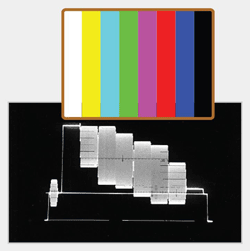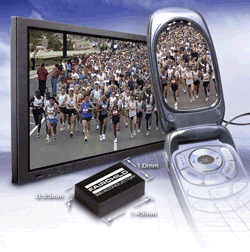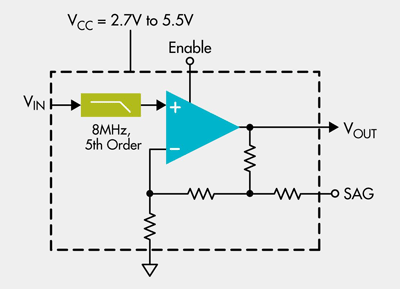What’s ‘in’ in video out
As the video equipment market changes constantly, it still needs to support analog outputs
BY BILL BOLDT
Fairchild Semiconductor
South Portland, ME
http://fairchildsemi.com
Video has been one of the most dynamic areas in electronics ever since the invention of television. Exciting waves of development followed the introduction of black-and-white television, starting with color TV, UHF channels, remote control, cable TV, higher and higher definition, flat-panel displays, big screens, digital cable and satellite, and now handheld (mobile) video.
The technology behind these waves has numerous facets such as advanced video compression, innovative display technologies (such as plasma, LCD , DLP, and now OLED), the conversion from analog to digital transmission, mobile tuners, in-home video networking, IPTV set-top boxes, and others to come such as blended TV/Internet and 3D displays.
Component suppliers, especially IC suppliers, have their own particular areas of interest within various video products and systems. So when looking at video trends it is necessary to consider the particular of point of view of the observer.
For example, an IC supplier like Fairchild Semiconductor that has been involved with video output technology possesses market and technology insight gained from such a perspective. Thus, it is from the video output viewpoint that we will consider the trends in video to articulate what is “in” in video out.
Prime directive
The iconic television show Star Trek has been around since the black-and-white days and has transitioned itself through many technological waves just like the video market itself. But really, Star Trek is mentioned here because the show popularized the term “prime directive,” which is very instructive in discussing the history of video.
To fully understand the development philosophy of video, one must appreciate that the prime directive has always been to ensure that everything new is compatible with everything that came before. Incredible intellectual capital and mental acrobatics have gone into advancing video technology while making it backward compatible at the same time.
For example, the color TV signal became very complicated (and ingenious) so it could be displayed on older-generation black-and-white monitors (see Fig. 1 ). Ever since then, video technology and market developments have been challenged by the heavy burdens of the prime directive of backward compatibility.

Fig. 1. Color TV video signal (displaying color bars).
What’s at the output
Looking at video from the output side, literally at the back-panel, one can see the arc of history of video almost like an archeologist looking at an excavation. The back panel of a typical set-top box has old and new technology and just about everything in between.
For example, it can have RF coax connectors, S-Video, Standard Definition (SD) composite video (CVBS), High Definition (HD) component video (Y, Pb, Pr), HDMI, audio R/L, Ethernet, USB, eSATA, digital audio (optical), IEEE 1394, and other things. Each of these connectors represents a long history of technological development and adaptation to the particular video product. The networking and storage technologies of Ethernet, 1394, USB, and eSATA each has its own storied and fascinating history, but we will focus here on the traditional workhorses of analog TV back-panel connections: composite video, component video, and the now-well-entrenched HDMI.
It is interesting to consider the future of analog outputs in a world that is becoming more and more digital. Video equipment is not only becoming digital, but both smaller and larger at the same time, with handheld video on one side and large screen video on the other (see Fig. 2 ).
This dichotomous situation is driving both the need for higher definition and for ways to enable higher- definition video to be stored on small handhelds, which will output the signals for display on larger screens. Storage of video on handhelds is being driven by the desire to physically carry movies and other content from place to place, which if you think of it, is ironically sort of the second coming of the “sneaker-net” concept that applied to computers prior to widespread networking.

Fig. 2. Video equipment is simultaneously getting bigger and smaller.

Fig. 3. Typical video-out connection schemes.
HDMI
The amazing high-quality resolution offered by 1080p has propelled the use of HDMI connectors (see Fig. 3 ) onto just about every piece of video equipment. HDMI’s value is that it allows the highest-quality video signals to be transmitted between equipment with built-in copy protection, thus making the folks in Hollywood comfortable with the distribution of digital HD content.
While some may look at HDMI as the holy grail of video interconnection, the prime directive dictates that the older analog connectors come along for the ride. However, there is some fraying of the prime directive around the edges. In order to save cost some DVD and set-top box equipment manufacturers, particularly in China, have started to eliminate the S-Video connector, which had really become virtually obsolete as it resides in a no-man’s land between composite and component video. The S-Video multipin connector is more expensive than composite’s simple RCA plug, but S-Video does not offer anywhere near the performance of component video.
Further violation of the prime directive has recently popped up with the Microsoft Zune HD video handheld being introduced with composite and HDMI connectors only, completely bypassing S-Video and component video all together. Apple, on the other hand, has been more true to the prime directive by supporting component video on the iPod, Touch, and iPhone for higher-resolution video output. So it is not clear if HDMI will completely supplant component video for handhelds, nor should it really. It can be argued that there still is an installed base of legacy monitors with component video but no HDMI, or with HDMI connectors already populated by other things, which would favor the continued support of component video on handhelds. In any case, it does look like S-Video will be “out.”
With the prime directive still having some sway, analog outputs will surely stay around for a while. Analog signals on video equipment require filtering because set top boxes and DVD players are sampled-digital at their heart. Therefore, sampling is always going to be part of the equation, and with sampling comes issues such as aliasing.
Aliasing happens when higher-frequency signals outside the video band like those from radio transmitters or local clock signals get folded back into the video band by an analog-to-digital conversion process. Video filtering is used to eliminate the undesirable distortion that aliasing creates or to eliminate noise stemming from signals replicated at higher frequencies during the ADC reconstruction process These unwanted signals can show up as clock moire, image sideband wiggles, and interference bands.
Video filters are usually low-pass active filters whose main components are operational amplifiers, capacitors, resistors, and inductors. A fifth-order Butterworth filter tends to be a good example of a useful consumer video filter due to its low phase error, high stability, low parts count, and effective filtering characteristics (see Fig. 4 ).

Fig. 4. Example of a video reconstruction filter-driver (standard definition).
Integrated video filters are attractive since they replace several discrete filtering components, usually around six per channel (not counting discrete ESD protection diodes). Due to their increased reliability and guaranteed specifications, integrated active filters generally have more consistent filtering characteristics than discrete active and passive filters.
IC filters are also a cost- and space-effective way to eliminate other problems inherent in video design such as electrostatic discharge (ESD). ESD protection is necessary in any electronic system, but even more important with mobile handheld products. This should be obvious to anyone who has received a shock from walking across a carpeted floor and touching a light switch.
Since they are carried around, mobile devices are more exposed to ESD events. Integrated video filters also save size not only from the integration of functionality but from their use of extremely small packages like Fairchild’s MicroPak MLP and wafer level chip scale packaging (WLSCP), making them ideal for mobile video platforms. Fairchild, for example, offers video filters in one to six channel configurations and resolutions from SD all the way to 1080p-HD.

Fig. 5. One- and three-channel video filters in packages so small they can be poured from a salt shaker
Even in an environment that is changing quickly from all-analog to digital, the prime directive still lives, so the video equipment market still needs to support analog outputs. The number of channels and the resolution of those channels will continue to be in flux so a wide selection of video filters will continue to be available from IC suppliers to meet those needs. Also, as energy conservation becomes even more of a concern worldwide, new filters will feature power-down modes to support Energy Star requirements and 3-V power supplies as systems move to lower supply rails to save energy. ■
Advertisement
Learn more about Fairchild Semiconductor





